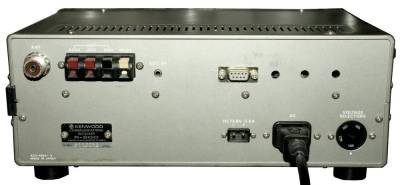Inhaltsverzeichnis
Kenwood R-600
Manufactured by Trio-Kenwood.
Three years after the introduction of the first shortwave receiver equipped with a digital frequency display, the venerable R-1000, the company Trio-Kenwood launched two successor sets, the more luxuriously equipped R-2000 and the plain R-600. In contrast to many other all wave receivers, the simpler version saved on many things that do not affect the peformance, and high-quality technology was used where it is necessary for a good reception result. In plain language: the triple conversion design and the IF filters are are of a high quality, unnecessary bells and whistles (how do I programme the sleep timer again…) were left out. What remains is a compact R-600 suitable for everyday DX.
Technical data
- frequency range: 150 kHz - 30 MHz
- Frequency display: digital display, 1 kHz
- Frequency memory: none
Power supply
- Mains operation: 110, 220 V
- Battery operation: 13.8 V DC
Dimensions
- 300 x 110 x 200 mm, weight 4.5 kg
Accessories
Operation
The Kenwood R-600 is a PLL-controlled SSB triple conversion superhet receiver that covers the complete shortwave range up to 30 MHz. It can be operated from different mains voltages or from 13 V DC and requires an external antenna, so it clearly belongs to the range of tabletop receivers.
The receiver, which has similar dimensions like the R-1000, measures 30 x 11 x 20 cm (wxhxt) and a weight of 4.5 kg. A carrying handle is attached to the right narrow side, if you like to take the set on your holidays.
The left third of the front panel is taken up by the front loudspeaker, below which are the headphones and tape line out jacks.
In the centre of the front panel are the display elements at the top, the analogue signal strength meter calibrated in S units and SINPO steps 1 - 5, and next to it the yellow-green LED frequency display, which indicates the reception frequency with an accuracy of 1 kHz.
On the left below the S-meter are three push-buttons, the mains switch, the switch for the noise limiter and for the 20 dB attenuator. Below that are two rotary controls, the volume control labelled AF (audio frequency) Gain and a tone control.
To the right of the frequency display and the large tuning knob with a finger recess is the operating mode switch at the top right of the front panel. In AM, two IF filter widths are available; in USB and LSB, the narrow IF filter is automatically active. Below that is the band selector, with which the desired MHz range is set - that's it, there are no more controls.
On the back of the receiver, next to the mains socket, is the mains voltage selector switch, the set can handle voltages between 100 and 240 V, and next to it is a socket for 13.8 V DC external power supply. Apart from a PL / SO-239 antenna socket, terminal connectors for long-wire antenna, earthing and muting of the receiver, there is only one jack to connect an external speaker.
For a full-blown DX shortwave receiver, setting up the R-600 is pleasantly simple: a long-wire antenna - I work with approx. 25 m long wire tuned with an FRT-7700, but a few metres of random wire in the antenna socket will do the job - connect the antenna, press the power switch and turn up the volume control to a low noise level. Set the MHz position to 6 with the rotary band selector, turn the tuning knob until the display shows 6.155 - and the news from ROI Vienna become audible. If you hear a whistle, the single sideband mode is probably still activated, the operating mode switch should be set to AM-Wide, possibly AM-Narrow, to receive broadcast stations.
 There are not many more controls to consider, in case of ignition noise, the noise blanker can be activated. If a nearby strong transmitter causes the S-meter to move to the right stop and appears as a „ghost signal“ on other frequencies, or if in an evening situation reception in the 49 m band is spoiled by a mishmash of mixing products from strong European stations, try to activate the RF ATT attenuator.
There are not many more controls to consider, in case of ignition noise, the noise blanker can be activated. If a nearby strong transmitter causes the S-meter to move to the right stop and appears as a „ghost signal“ on other frequencies, or if in an evening situation reception in the 49 m band is spoiled by a mishmash of mixing products from strong European stations, try to activate the RF ATT attenuator.
Technical principle
Triple conversion superhet, PLL synthesis.
Components
The set is completely solid state.


